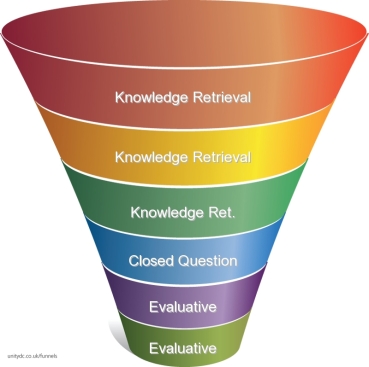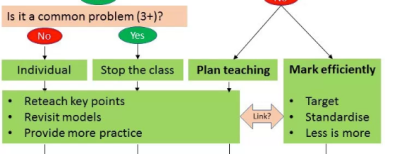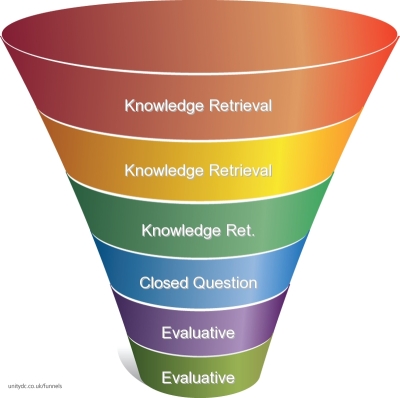
We often associate the practice of questioning as a tool to evoke higher-order thinking; it challenges our students to think in an evaluative and speculatively manner. However, the way we implement questioning should perhaps be considered more thoughtfully in our planning whereby we confirm our students’ knowledge before challenging.
Doug Lemov is notable in his remark that “simply asking higher cognitive questions does not necessarily lead students to produce higher cognitive responses” (2005). This presents us with a complex dilemma as we are aware that pushing our students to think more critically is the requirement for their future academic exam, and indeed their later work and academic successes. We are good at building the scaffolds to ensure a greater success in complex questions – but do we do this enough? And do we approach this in the right way?
It was in a recent CPD event in London run by Lemov that clarified this. He gave a similar example to the one below:
- Write down 10 questions you would ask students about the following painting:
(Assuming at this point that you have limited or no knowledge on the painting itself).

Some of your questions might have contained the following: What is the significance of colour? Why is the hand positioned this way? How does this differ from the painter’s original style? What is the significance of the painting? Etc etc…
Now, if you add the following knowledge about the painting Tu m’ – Duchamp:
Artist: Marcel Duchamp, American, born France, 1887–1968
Title: Tu m’
Year: 1918
Medium: Oil on canvas, with bottlebrush, safety pins, and bolt
69.8 x 303 cm (27 1/2 x 119 5/16 in.)
Gift of the Estate of Katherine S. Dreier
1953.6.4
Details: Tu m’ was commissioned by artist, collector, and educator Katherine Dreier to be hung over a bookcase in her library, hence the unusual length and frieze-like shape of the work. Executed in 1918, it is Marcel Duchamp’s last painting on canvas and sums up his previous artistic concerns. Ranging across the canvas from left to right are cast shadows that refer to three “ready-mades”: a bicycle wheel, a corkscrew, and a hat rack. Several objects are rendered illusionistically, such as a painted hand with a pointed finger in the lower center. Providing counterpoints to these trompe l’oeil elements are real objects: a bottle brush, a bolt, and safety pins. Duchamp summarises different ways in which a work of art can suggest reality: as shadow, imitation, or actual object. The title lends a sarcastic tone to the work, for the words, perhaps short for the French “tu m’emmerdes” (you annoy me) or “tu m’ennuies” (you bore me), seem to express his attitude toward painting as he was casting it aside.
Culture: French, American
Period: 20th century
This, alongside the knowledge that the omitting on the verb in the title was also said to translate to ‘you [blank] me’ highlighting Duchamp’s apathy towards traditional art and a final farewell to painting. Coincidentally, this painting was also commissioned a year after Duchamp’s (R. Mutt’s) The Fountain – arguably the first piece of conceptual art.
Now. Go back to the task.
Write down 10 questions you would ask students about the following painting.
With the knowledge above, not only do my answers to the original questions (What is the significance of colour? Why is the hand positioned this way? How does this differ from the painter’s original style? What is the significance of the painting? Etc etc…) become more insightful, but I can now access more complex and challenging questions such as:
- To what extent does this painting differ from Duchamp’s original style?
- In what ways does this painting critique classical art?
- Art is “not what you see, but what you make others see.” Discuss this in relation to Tu m’ by Duchamp
Therefore, it seems pointless to ask complex questions if we have not yet tested our students’ understanding in the first place… and, quite frighteningly, it seems we can actually lock some students out of learning if we do not test their understanding first. It is knowledge that makes this challenge accessible.
And Motivation?
Answering the complex questions above actually feel far more exciting with the information that is now given about Duchamp’s final painting. This idea that knowledge motivates us is something that has been explored quite frequently. Burke (1995) asserts in his paper ‘Connecting Content and Motivation’ claims that
“Content when it is applied, or has meaning assigned to it, is important, and we also know that motivation facilitates content assimilation”
and further continues to assert:
There is little debate, however, that learner motivation, the incentive applied to activate or engage student learning, enhances achievement levels, promotes higher order thinking, stimulates reflective analysis, and induces improved student performance in routine content assimilation. Thus, when motivation coalesces with curricular components, learning is considerably more residual and consequential.”
It would also explain why the following conclusions have been made over again in studies that show the importance and impact of direct instruction. Hancock’s Influencing Postsecondary Students’ Motivation to Learn in the Classroom (2002) believed to find a direct correlation between motivation in Low Conceptual Learners and ‘Direct Instruction’ teaching.
And, of course, why Willingham, Lemov, Hendrick & Macpherson, Christodoulou (vid below) and others come back to the importance of testing knowledge – and smaller skills – before moving onto more challenging or conceptual ideas.
The value of this in the learning process has also been implemented nicely in Fletcher-Wood’s new blog about The Evidence on Feedback: A Decision Tree whereby there is an active step to ‘reteach’ material where it seems students have missed key information.

As mentioned earlier, if you do not have the foundational knowledge to answer a question then you can become locked out of the learning – in the same way that my responses will be only so limited on Duchamp’s Tu m’ unless I can easily access the factual knowledge about the painter and the painting itself. Following that, the feedback tree seems an important message in addressing misconceptions and testing core knowledge before redrafting work
A Solution? Question to confirm… and then to challenge.
If I wanted to explore the significance of how Lady Macbeth in portrayed in the following extract, I would expect students to use their understanding of devices to see how Shakespeare has positioned Lady Macbeth to us here.
Come, you spirits
That tend on mortal thoughts, unsex me here,
And fill me from the crown to the toe top-full
Of direst cruelty. Make thick my blood.
Even though I may have taught this section of the play last lesson, explored the extended metaphor and considered the use of imperatives, as Dylan Wiliam has said: ‘learning requires forgetting.’ 90% of my students may remember all of this knowledge but the value of questioning all of them on their basic knowledge means that all students can access the higher order question that I want them to answer (‘Explore the significance of how Lady Macbeth in portrayed in the following extract’). Which, to some students, might look just as chaotic as Duchamp’s painting unless reminded of the core facts.
Thus the questioning process could funnel (funnel to refine!) similar to the following:

Initial questions may focus on knowledge retrieval, and then move to closed questions to prompt all students to develop an argument (keeping the learning accessible despite a more subjective response), and then finally to more challenging questions. In the Macbeth example given above, it would look like:
- What is a metaphor?
- What does ‘unsex me here’ metaphorically mean?
- What is an imperative verb?
- List the imperative verbs above.
- In your opinion, do the imperative verbs and metaphor show Lady Macbeth to be a confident or controlling?
- Does Shakespeare present Lady Macbeth confident or controlling here? Give evidence.
- Explore the significance of Lady Macbeth in the following extract.
Note that Question 5 is where subjective opinion is required, however, I have also used key vocabulary to guide the students’ response. This is a good way to ensure unconfident students have the tools and vocabulary to access the more challenging question you want them to answer.
For Questions 6-7, it is important that if you were going to discuss or write this, that you give students Wait Time. They are not knowledge retrieval questions and Lemov is very assertive about giving space for students to formulate their best response rather than simply taking the first response. Again, alluded to by Wiliam because ‘the answers of the confident students are a bad guide to what the rest of the class is thinking.’
Whilst I have used 7 questions above, you could undoubtedly use 10-20 questions depending on the material being studied in that lesson. This is, of course, just a example to demonstrate how knowledge retrieval can assist in enabling all our class to effectively access the material that they are required to know, understand and manipulate. However, I think what is important here is ensuring that the material is accessible through simple knowledge retrieval questions that will further consolidate the memory pathways used by our students when presented (and re-presented) with the curriculum.

I found this an excellent explanation of the importance of using knowledge retrieval questions as a way of setting up successful responses to higher order questions from all students. I think in the past I have been guilty of ‘saving higher order questions for higher ability students’. This post showed me that planning the use of knowledge retrieval questions is a way of scaffolding the response (and strengthening knowledge storage and retrieval) for all ability levels. Thanks.
LikeLike